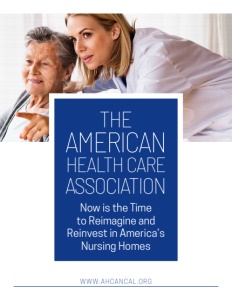The American Health Care Association
Now is the Time to Reimagine and Reinvest in America’s Nursing Homes
By Dr. David Gifford, MD MPH
Like many businesses and aspects of our society, the COVID-19 pandemic exposed and exacerbated systemic issues in America’s long term care system. In our case, it was workforce recruitment and retention, often associated with chronic government underfunding. Now, these issues are a full blown crisis.
Thousands of long term care facilities are in danger of closing because they cannot find enough staff to properly care for their residents or cannot bear the weight of ongoing COVID expenses. More than five million seniors and individuals with disabilities each year rely on round-the-clock care in long term care facilities to recover from their hospitalization or when they can’t return home. These vulnerable individuals deserve access to high quality care provided by dedicated caregivers, and long term care facilities need the support of policymakers to make it happen.
The American Health Care Association (AHCA) has proposed a variety of strategies and solutions to improve the long term care economic and workforce crisis in the Care For Our Seniors Act. These strategies will address some of the long-standing issues in America’s nursing homes and provide meaningful investments to our seniors’ care.

Building a Pipeline of Caregivers
Workforce recruitment and retention is one of the most pressing challenges confronting nursing homes and other long term care providers today. The health care system has experienced a shortage of trained caregivers for critical roles for some time; nurses and nurse aides are among the fastest growing occupations, but supply is not keeping pace. The federal government estimates nearly 27 million people will need some kind of long term care by 2050, magnifying the workforce shortage that already exists.
The pandemic exacerbated the crisis as staff members got sick, had to isolate, or lacked childcare options. At the same time, already thinly stretched staff members had to do more than ever before, as residents required additional one-on-one care to help prevent the spread of the virus, as well as fill the void of loved ones who could not visit in-person.
It is time we addressed this chronic crisis. We need a comprehensive strategy to recruit more health care heroes to serve our nation’s seniors and individuals with disabilities.
The Care For Our Seniors Act offers a multi-phase tiered approach to supply, attract, and retain the next generation of caregivers leveraging federal, state, and academic entities. This includes loan forgiveness for new graduates who work in long term care, tax credits for licensed long term care professionals, and programs for affordable housing and childcare. We should also incentivize higher learning institutions to train new caregivers through increased subsidies to schools whose graduates work in nursing homes for at least five years. Also, nursing homes need resources to invest in their workforce and offer more competitive wages and benefits, so policymakers must fully fund nursing home care.

Financing These Reforms
Real, long-lasting transformation that will best serve our residents requires a considerable investment in the long term care profession. Providers stand ready to make meaningful changes, but it won’t be possible without a commitment from policymakers to provide the necessary and consistent financial support.
Most of our residents rely on Medicaid to pay for their daily care, but the government program only reimburses providers 70 to 80 cents on the dollar of what it takes to deliver care. This means the average nursing home barely breaks even, leaving many unable to afford enhancements in their care delivery, workforce, and infrastructure. Fully funding Medicaid would allow providers to offer more competitive wages and benefits to frontline caregivers.
COVID-19 has exacerbated these economic challenges. Nursing homes have spent tens of billions responding to the pandemic, specifically personal protective equipment, testing, additional staff, and bonus pay. Coupled with significant revenue losses due to fewer new residents, the nursing home industry expects to lose $94 billion over the course of the pandemic. As a health care provider that relies almost entirely on government reimbursement, nursing homes cannot make substantial reforms on their own. They need the support of federal and state policymakers and resources.
We must not let something like the pandemic happen in long term care ever again, and we must prepare for a growing elderly population. AHCA is eager to work collaboratively with the Biden Administration and Congress to implement significant reforms that will protect and improve the lives of our nation’s seniors.
To learn more, please visit www.ahcancal.org/solutions.
*Dr. David Gifford, MD MPH, is the Chief Medical Officer at the American Health Care Association/National Center for Assisted Living (AHCA/NCAL) in Washington, DC.
AT A GLANCE
The American Health Care Association
WHAT: Represents nursing homes and assisted living providers through its National Center for Assisted Living (NCAL)
WHERE: Based in Washington, DC
WEBSITE: www.ahcancal.org


